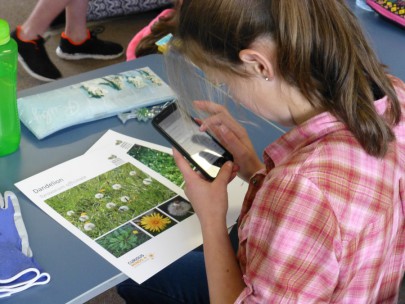Whataroa School, Westland
In this section
-
Participating schools
- Curious Minds visit Lincoln
- Franz Josef & Fox Glacier Schools
- Greymouth High School
- Haast School
- Halswell Domain
- Halswell School
- Heathcote Valley School
- Kaniere School
- Kaniere visit Lincoln
- Hokitika Primary
- Leeston Consolidated School
- Manuka Primary School
- Mission Heights
- Mt Albert Grammar
- Paroa School
- Rudolf Steiner School
- Takapuna Grammar
- TKKM
- Wakaaranga Primary School
- Whataroa School
This was the first of our school visits for the Unlocking Curious Minds project and was timed to coincide with Conservation Week (10–18th September) and the US Embassy’s desire to demonstrate support for conservation-related rural citizen science.

Using a weed identification app.
At Whataroa School, we were warmly welcomed by Principal Jenny Bainbridge and a waiata from the school (comprising 34 junior and senior students) before everyone went on a field trip out to the school grounds and to a large block of land behind the school. The 22 senior students photographed, recorded and identified weeds using the smartphones and preinstalled apps that we provided.
Robert Tate, Country Public Affairs Officer from the US Embassy in Wellington, joined in on the field trip – rolling up his sleeves and pitching in. Afterwards, Rob addressed the school on US conservation initiatives and marked the 100th anniversary of the National Park Service.
Nina Robb, a DOC Biodiversity Ranger and Weedbuster from Westland, provided great advice and local expertise. She had helpfully scouted out the field trip area beforehand and joined in on the field day, encouraging and motivating the students. Nina rejoined us on a later trip to Franz Josef Glacier School.
The following day, Robinne Weiss (our contracted South Island Educator) joined us to lead the classroom-based activities. In one activity, students designed and drew their own gardens, and this was used to discuss plants used for food, ornamental purposes and those that can escape into the wild. In another activity, students used a ball of string to create a ‘web-of-life’ between different plants and animals (aka students with various name badges). Robinne’s expertise and experience proved invaluable for this project.
What was learnt from this first visit?
- It was amazing how quickly even primary school students understand science apps.
- Students also enjoy hands-on science such as putting their plant specimens into our field presses.
- That the project could meet an education need and excite curious minds was confirmed: “best day ever!”, “I’m right into this!”, and “when are you coming back?”
What were some of the plants that we found?
We found a bevy of environmental weeds typical of Westland, and indeed common in most other areas of New Zealand, including:
- blackberry (Rubus fruticosus)
- cotoneaster species
- creeping buttercup (Ranunculus repens)
- English ivy (Hedera helix)
- European holly (Ilex aquifolium)
- gorse (Ulex europaeus)
- Himalayan honeysuckle (Leycesteria formosa)
- Scotch broom (Cytisus scoparius)
- tradescantia (Tradescantia fluminensis)
- tree privet (Ligustrum lucidum).
Summer snowflake (Leucojum aestivum) was found growing in the school grounds. It was probably originally planted there but can be a weedy species.
We also discovered on the school grounds a young cherry laurel (Prunus laurocerasus) plant. We later found the likely seed source of this plant growing as a mature tree in the adjacent Whataroa Golf Course. Cherry laurel can become quite invasive and is becoming an increasing problem in Westland and other areas of New Zealand.











![Whataroa student recording the summer snowflake ([Leucojum aestivum]) Image](/assets/Education/Schools-Great-weeds-hunt/80_Whataroa_Using_Apps__FillMaxWzE1LDE1XQ.jpg)
